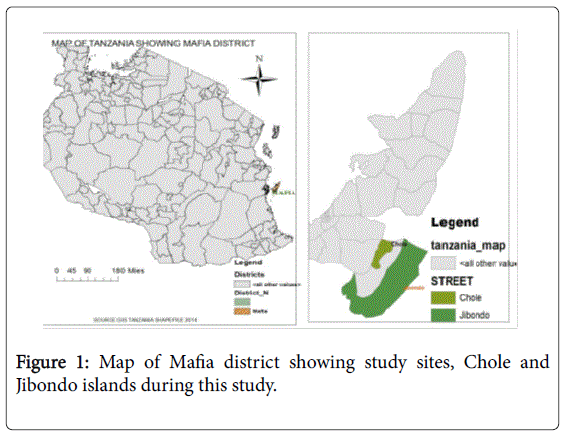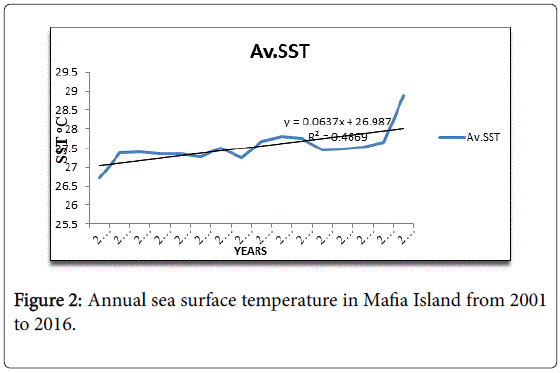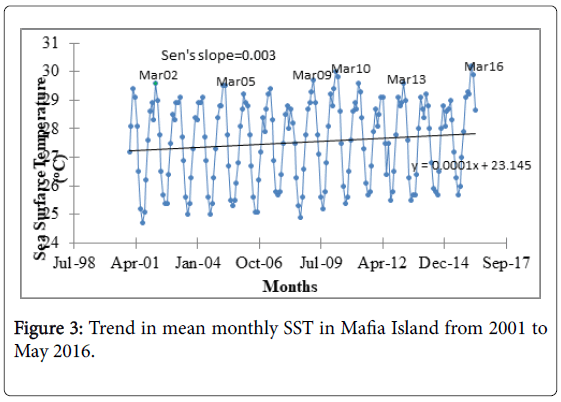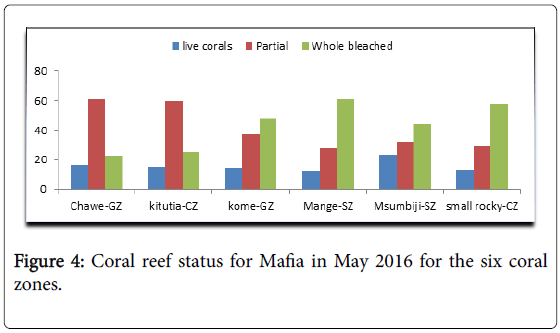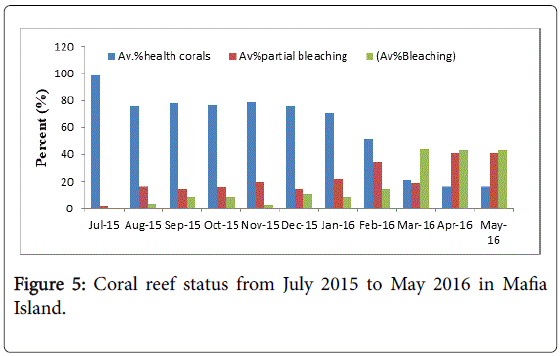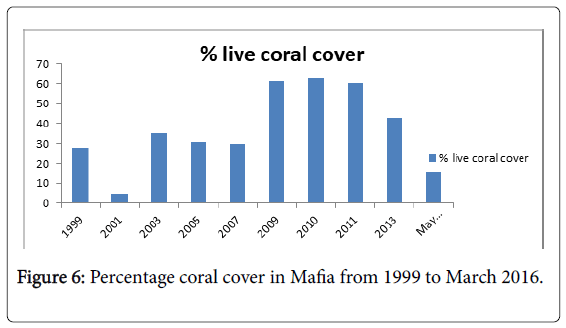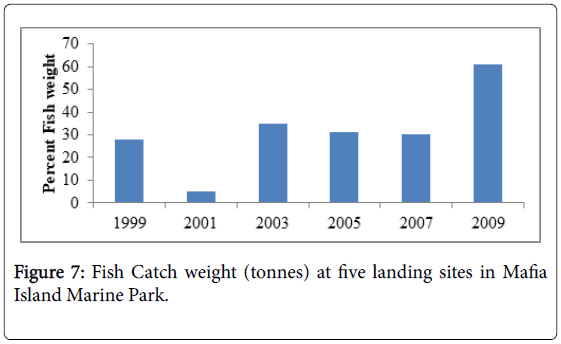Impacts of Sea Surface Temperature on Coral Reefs in Mafia Island, Tanzania
Received: 22-Feb-2018 / Accepted Date: 28-May-2018 / Published Date: 31-May-2018 DOI: 10.4172/2155-9910.1000253
Abstract
Coral reefs are very sensitive and vulnerable to Sea Surface Temperature (SST) rise than their optimal maximum temperature (27°C). SST rise do not only affect coral reef but also fishery production. Line Intersect Transect (LIT) and key informant interview have been used to study the effect of SST on coral reefs in Chole bay and Jibondo in Mafia Island. Sea Surface temperature in Mafia has increased by 0.56°C since 2001 up to 2016. This increase has significant effect on coral reef health, as it causes coral bleaching and reduction of fish catch. In Mafia Island increase in SST from November 2015 up to April 2016 was exacerbated by El Nino incidence in the Indian Ocean. The El Nino incidence was very strong with the temperature rise of 2.3°C. Almost 50% of coral reefs in Mafia have been bleached in 2016 while from 2001 bleaching varied in yearly basis. That's, coral reefs tend to bleach from January to March in every year and recover from September to November in every year, but the 2016 bleaching incidence was very severe since, 40-60% was bleached in mafia Island.
Keywords: Sea surface temperature; Coral bleachin; Cral cover; Coral fishery; Coral recovery
Introduction
Warming of oceans has been observed and recorded globally. Increase in climate change and variability extremes such as heat waves, global temperature rise and El Nino events are the major drivers for Sea Surface Temperature (SST) rise [1,2]. Recent scientific findings shows that that the currently observed rise in SST results from global warming as a result of climate change (confidence about 95%) [1,3,4].
SST alters marine abundance, geographical distributions, migration patterns, and timing of marine species; this is paralleled by reduction in maximum body sizes in warming [5].
Coral reefs are among major productive coastal marine ecosystems; they prevent coastal erosion, flooding and regulate the pH. Coral reefs are the breeding and nursery sites for fishes and invertebrate organism like parrot fishes (Scaridae ), surgeon fishes (Acanthuridae ), rabbit fishes (Siganidae ), damselfishes (Pomacentridae ), wrasses fishes (Labridae ), butterfly fishes (Chaetodontidae ), snappers (Lutjanidae ); and tiger fishes (Balistidae ) [6-10]. Over 70% of coastal communities depend on coral reef resources as sources of livelihood [9,11].
Coral reefs live symbiotically with photosynthetic, unicellular micro algae known as zooxanthellae [12,13]. Zooxanthellae are highly sensitive and vulnerable to sea surface temperature rise [5]. Increase in SST above the optimal maximum temperature (27°C) affects the light dependent reaction (photo system) of zooxanthellae; this is due to production of oxygen intermediates like include superoxide radicals, singlet oxygen, hydrogen peroxide, and hydroxyl radicals during photo system I in steady of normal oxygen gas [5,14].
The intermediates damage lipids, proteins, and DNA of the chloroplast which are responsible for electron transport chain as well as photo system II, thus resulting into degradation of chloroplast leading into death of cells of Zooxanthellae which affects the symbiotic relationship leading into expulsion of zooxanthellae which causes whitening of corals [12,14].
Coral bleaching reduces the percentage live coral cover in the Oceans, and triggers change in coral community structure and fishery. Bleaching event of 1998 in Tanzania, bleached almost 80% of corals in areas of Mafia, Kilwa (Songosongo ), Rufiji, Zanzibar and Tanga [7,13]. Ever since 1998 El Nino event, coral bleaching incidents has continued to occur even though at smaller magnitudes continuously affecting artisanal fish production, tourism industries, and increase in frequency and magnitude of storm surge and coastal erosion in Tanzania [2,14]. This study aimed at providing information on the extent increased SST affects coral cover and coral fishery in Mafia Island, Tanzania.
Material and Methods
Study area
Mafia Island is found in the Indian Ocean 15km from Rufiji delta. It is 70°5’S and 39°47’E and, it is 50 km long to 15 km across with an area of 394 km2. The study covered two sites; Chole bay and Jibondo Island. These are important site since have a lot of corals (75%) with plenty fish species and they are within the Mafia Island Marine Park. The Marine Park controls all anthropogenic threats to coral reefs (Figure 1).
Study design
Qualitative and quantitative methods were used to collect primary and secondary data. Six zones were established in the study area where three zones in Chole Bay (Msumbiji, Small rock and Chawe) and other three zones in Jibondo Island (Kitutia, Mange and Kome).
Purposive sampling was used to determine participants for key informant interviews from marine reserve officers, village fishermen, Bigblu Diving centre and Frontier Marine Conservation centre. A transect of 40 meters for LIT were established with 14 metre Secchi disk to measure for transparency and turbidity of water.
Key informant methods were used to obtain information from Frontier Marine conservation in Mafia on organisms such as cephalopods, gastropods and echinoderms which live within the coral cover. Fish catch data for 6 years (2006-2011) from five landing sites within Mafia Island Marine Park areas were obtained and daily sea surface temperature data for a period of 15 years (2001-2015) for Mafia Island station were collected, both from Mafia Island Marine Park Authority.
Sampling and data collection
SST data for 15years (2001-2015) and from January to March 2016 were obtained from the Centre for oceanography which is located at the Institute of Marine Sciences in Zanzibar-Tanzania. Line Intercept Transect (LIT) method was used to collect data for estimation of percent total coral cover, bleached coral, hard corals, soft corals, rubles, coralline and bare rocks. Annual fish catch data were obtained from Mafia Marine Park Authority and Key informant interviews were employed from four experienced fishermen who have been practicing fishing activity for more than 30 years in order to get more information on fishing taking place in coral reef areas.
Data processing and analysis
SST data were analyzed using Mann-Kendall trend test with the aid of XLSTAT software to examine patterns and trends, Pearson Correlation analysis were used to determine whether there is relationship between sea surface temperature and Coral bleaching. Content analysis method was used to analyze qualitative data obtained through key informant interview and estimation method was used to find the Percentage covered by health (Coral cover).
Results
Trend analysis tool was implemented on Sea surface temperature data a, results show a positive increase in trend of Sea Surface Temperature (Sen.’s slope=0.003) by 0.56°C from 2001 to 2016 (p<5% confidence level (p = 0.001) (Figure 2).
High sea surface temperatures of 29°C to 30°C or in some cases 31°C were recorded in March and April every year while lower sea surface temperature of 25°C was recorded in August every year (Figure 3).
The percentage live corals in May 2016 were recorded to be low in Msumbiji (Specified user zone) 24%, Chawe (General user zone) 16% and lowest in Kitutia (Core zone) 15% and Kome (General user zone) 15% even though they are less than 50%, while in Small rock and Mange which are restricted coral zone live corals were lowest (13% and 12% respectively). Bleaching were observed and recorded to be very high in Mange reef 61%, Small rock 58%, Kome 48%, Msumbiji 44% while less in Chawe 23%, Kitutia 25% (Figure 4).
Bleaching incidence in Mafia Island Marine Park from July 2015 to March 2016 show that live corals were 98.53% in July 2015 and decreased to 16% in April - May 2016. High percent of Whole bleached coral was recorded from March to May 2016, results show that 43% Coral bleaching incidence started to be observed from August (31.9%) within an increasing trend up to May 2016 as shown (Figure 5).
Pearson correlation analysis was implemented; there was negative relationship (-0.509) between percentage live corals and sea surface temperature, indicating that live corals decrease with increase in SST increasing with a coefficient of determination, R2=0.256, results for the correlation between SST and whole bleaching indicate that, there is positive relationship 0.51 which is significant indicating that, number of whole bleached corals increase with increases in SST and coefficient of determination, R2 =0.192.
Percentage live coral cover in Mafia Island was recorded to increase by 55% from 5% in 2001 to 60% in 2011 and it is estimated to decrease by more than 40% by 2016 Figure 6).
Fish catch
Fish catch in Mafia Island Marine Park (coral reef fishes) was seen to decrease from 2006 to 2010. Results for five landing sites within the marine park area indicated an increase in fish catch by 50% from 25 tonnes 2006 to 100 tonnes 2010. Maximum fish catch was 100 tonnes recorded in 2010 while minimum fish catch was 12 tonnes recorded in 2008 (Figure 7).
The varieties of fish species were recorded in the fish catch, and these species include Acanthuridae, Scaridae, Siganidae, Lethrinidae, Gerridae, Lutjanidae, Mullidae, Haemullidae, Carrangidae and Serranidae. Results (Figure 7) show that, fish catch from 2006 to 2011 were dominated by Lethrinidae species (Carnivores), and in 2007, that is 2500 tonnes of Lethrinidae were recorded which was the highest value for all six years.
Correlation analysis (0.595) showed that there was significant weak moderate linear positive relationship between fish catch and live coral cover (R2=0.390). Results from Pearson correlation analysis (-0.306) between Lethrinidae sp and percentage live corals shows weak linear negative relationship (R2=0.094). This means that, the high catch of Lethrinidae was not dependent or defined by the live coral cover.
Discussion
Global warming has been identified to be the key driver for the current increase in sea surface temperature in the world. Oceans have been warming globally leading to an increase in sea surface temperature NOAA[15]. IPCC [2] verify that, SST has increased than normal and it is mainly due to human influence as a result of greenhouse gases emission.
This study observed that, SST in Mafia Island has increased by 0.56°C from 2001 to May2016 (Figures 2 and 3). This concurs with Maheshwari [16] that sea surface temperature of the Indian Ocean has been increasing by 0.696°C from 1982 to 2011. SST increase varies yearly; majority ranged from 0.3 to 0.9°C since 2001 up to 2016. During March to April in every year SST range from 28°C to 30°C in Mafia Island; however, in the year 2016 SST was 31°C in March and 30°C in April with monthly increase of 2-3°C from the normal seasonal maximum SST (Figure 3). This was due to El Nino incidence observed and recorded from November 2015; the strength of this El Niño was classified to be very strong due to temperature rise of 2.3°C [7,17].
Increase in SST from the normal seasonal season maximum for corals to survive (27°C) has severe impact on corals since zooxanthellae are vulnerable to such increase [14]. This increase affects the light dependent reaction of photosynthesis process of zooxanthellae algae by triggering production of oxygen peroxide species. These species damage cells of the algae leading into death of zooxanthellae, and expulsion from the coral; hence bleaching [12,14]. Therefore increase in SST of 0.56°C in Mafia Island from 2001 to 2015 has influence on coral bleaching even though it has been outcompeted by high rate of recovery due to effective management and monitoring of corals put forward by Mafia Island Marine Park.
Coral bleaching in Mafia varies in yearly basis since SST increase vary from year to year (Figure 2), and most bleaching incidence were observed from March to April every year (2001 to 2015) where most of SST increase ranged from 1.5°C to 2°C. That is why bleaching in Mafia Island has been observed from March to April and recovers from June to December when SST drops to normal season maximum. Coral reefs recover well when anthropogenic induced impacts to coral like illegal fishing and coral mining are not severe [18]. Prolonged bleaching affects immunity of coral reefs, in such a way that, they can be attacked by diseases leading to death and reduce live coral cover [12]. In Mafia Island, the 1998 massive bleaching reduced almost 70% in areas like Kitutia, Mange, Chole bay and Utumbi [9,19].
However, bleaching incidence of the year 2016 was very high (Figure 6); this was due to El Nino incidence with SST increase ranging from 2.3°C to 3°C from February to June. This increase has severe impact to zooxanthellae and sustained for a long period (almost five months) compared to previous year (2001 to 2016) when such increase last for one or two months only.
Almost 60% of corals in Mafia Island were bleached by June 2016, (Figures 5 and 6). Similarly, more than 50% of coral reefs have bleached in northern part of Australia while in other part bleaching was recorded to be only 20-30% [20]. Wilkinson [18] described that El Nino event of 1998 caused 80% of coral bleaching of the world.
Rate of coral covers recovery in Mafia observed to be high from 2001 to 2009 where coral cover recovery increased by 30% as shown in Figure 6. Similarly Muhando [19] clarified that, rate of coral recovery was increasing and it was expected that, live coral cover to be 80% by 2015 and was expected to be 100% by 2020. In addition , coral reefs status of the world reports of 2004 and 2008 explains that, world’s coral reefs has been recovering from the 1998 massive bleaching event even though, and only those which are within the marine park recover well while those which are outside the marine park recover at low rate.
Mafia Island Marine Park is responsible in managing and monitoring corals found in Mafia, and has categorize coral zone into three zone, that is core zone area where any human use have been prohibited to take place example Kitutia and Small rock, Specified zones where human activities were allowed under special permission like Mange and Msumbiji and General user zone where it is open and free for sustainable human activities. This strategy has accelerated the rate of coral reef recovery in Mafia and Up 60% by November 2015. Human activities degrade the bleached corals because they have been weakened by bleaching event (Figure 6). Similarly, Coral reefs status of the world [18] document that, the rate coral reef recovery in the Indian Ocean has increased from 2% 1998 to 70% in 2008. The projection didn’t take into consideration on some uncertainties like the occurrence of very strong El Nino (Southern Oscillation) which has caused more than 50% bleaching in Mafia Island (Figure 6). It is extremely likely that this incidence will reduce more than 50% of the live coral cover in Mafia islands especially in general user zone within the marine park and in areas which are outside the marine park since human activities like fishing and transportation can destroy or weaken more the bleached corals leading into death. Prolonged bleaching may lead to death of coral reefs which favors algal community which colonizes the areas with dead coral leading into decrease of coral cover [21].
Coral cover comprises of live corals (stony or hard and soft) and other benthic community such as Coralline, sea grass, sands, bare rocks and rubles. Coralline algae prevent growth of algal community which has impacts on recovery of coral reefs [19]. Bleaching incidence affects coralline growth and reduces coral cover [22].
Increase in percentage live coral cover influence fishery production in the world (Figure 7). Live coral cover can support more fish species per unit area than any other marine environment [7].
Most fishes in Mafia Island which are utilized and exported to other part of the country come from coral zone areas. Also almost 90% of the Coast of Mafia Island was covered with coral reefs, however only 75% of Mafia Island have health corals since it was within the Marine Park areas.
The general coral fish catch in Mafia Island Marine Park has increased by almost 80% from 2008 to 2010 and from 2006 to 2010 by 50%; this can be linked with the increase in coral cover which offers habitats and nursery for variety of fishes as shown in Figure 7. Similarly, study conducted by Reaka-Kudla, [7] clarified that coral cover offers variety of ecosystem services to fish species such as breeding sites and nurseries and this was because they have ability to support more fish species per unit area than any other marine environment.
Varieties of fish species commonly found in Mafia Island coral zone specifically in the marine park area were observed. These include Parrot fishes; Surgeon, Rabbit fishes and Damselfishes which are herbivorous fishes, Snappers, Surgeon fishes and wrasses which are planktivores together with Trigger fishes, Emperor and Butterfly fishes. All these fish species are essential for coral health as they live symbiotically with coral reefs. Herbivory fishes feed on algal community and favors coral reef recovery [22]. Machano [23] asserted that, presence of herbivores fishes in fish catch at high amount implies that coral reefs recovery was increasing since they are ecologically important for coral reef health. Similarly Obura [22] confirm that, Scaridae, Siganidae and Acanthuridae fish species are ecologically important in the marine ecosystems, as they feed on algal community (brown algae and Sargassum) which out compete growth of corals favoring coral reef recovery [24-28].
Acknowledgement
My ultimate thanks go to the omnipresent God without whom my existence would never have been. In a particular way, I would like also to thank my supervisor, Dr. Lulu T. Kaaya for her invaluable advice, encouragement and guidance that led to the production of this article.
I would also like to express my gratitude to the management of Center for Climate Change Studies through CCCS/NORHED Program for granting me a scholarship that covered the expenses of my Master’s program and production of this report. The work in the field would not have been feasible without the competent assistance from key respondents from Mafia Island Marine Park, Big blu Diving centre in Mafia, World wide Fund for Nature and other respondents, from Chole and Jibondo who took time out of their daily busy schedules to discuss with me.
Finally, I would like to extend my sincere thanks to my friends; Musa Ndoo, Julius Pagu, Veronica Gombo for their valuable contribution on this report. I cannot forget Dr. James T. Zacharia for his wise counsel.
References
- Intergovernmental Pannel on Climate Change synthesis Report (2007) Contribution of Working Groups I, II and III to the Fourth Assessment Report of the Intergovernmental Panel on Climate Change. IPCC, Geneva, Switzerland
- Intergovernmental Pannel on Climate Change synthesis Report (2014) Contribution of Working Groups I, II and III to the Fourth Assessment Report of the Intergovernmental Panel on Climate Change. IPCC, Geneva, Switzerland
- Awuor CB, Victor AO, Andrew A (2008) Climate Change and Coastal Cities: The Case of Mombasa, Kenya. Environment and Urbanization 20: 231-242.
- World Meteorological Organization (2013) a summary of current climate change findings and figs: WMO report
- Guldberg H, Bruno FJ (2010) The Impact of Climate Change on the Worlds on Marine Ecosystems. American Association for the Advancement of Science 328:1523-1528.
- National Oceanic and Atmospheric Administration NOAA (2016) reports on El Nino (Southern Oscillation) and La Nina.
- Reaka-Kudla M (1997) The global biodiversity of coral reefs: A comparison with rain forest. The national academy of science.
- Whittigham E, Campbell J, Townsley P (2003) Poverty And Reef, Global Overview. UNESCO l: 1260.
- Wagner MG (2004) Coral Reefs and their Management in Tanzania. Western Indian Ocean J. Mar. Sci. 3:227–243
- Yahya AS (2011) Habitat structure, degradation and management effects on coral reef fish communities. Stockholm, Sweden.
- Obura D, Grim G (2009) Coral Reefs, Climate Change and Resilience. IUCN World Conservation Congress.
- Backer AC, Glynn PW, Bernhard R (2008) Climate change and Coral bleaching: An Ecological assessment of long term impacts, recovery trends and future outlook. Estuary, coast, shelf Science 80: 435-471.
- Elmlund L (2009) The threat of Climate Change to Coral Reefs. Department of Physical Geography and Ecosystems Analysis Lund University Seminar series 165: 5-9.
- Brown EB (1997) Coral bleaching: causes and consequences. Coral Reefs 16:129-138.
- National Ocean Atmospheric and Administration (2011) Report on The variety of species living on a coral reef is greater than in any other shallow-water marine ecosystem, making reefs one of the most diverse ecosystems on the planet, Florida,USA.
- Maheshwari M, Singh RK, Oza SR, Kumar R (2013) A Investigation of the Southern Ocean Surface Temperature Variability Using Long-Term Optimum Interpolation SST Data. ISRN Oceanography 1:9.
- Golden gate weather service (2016) El Niño and La Niña Years and Intensities based on Oceanic Niño Index (ONI).
- Wilkinson (2008) Status of coral reefs of the world. Global Coral Reef Monitoring Network.
- Muhando C, Mohammed S (2005) Coral Reef Benthos and Fisheries in Tanzania before and after the 1998 Bleaching and Mortality Event. In Western Indian Ocean Journal of Marine Sciences (WIMOSA) book series, Marine Science Development 1: 43-52.
- Westmacott S, Teleki K, Wells S, West JM (2000) Management of bleached and severely damaged coral reefs. IUCN, Gland, Switzerland and Cambridge, UK
- Obura OD (2008) Baseline assessment of the coral reef ecosystems of Mafia and Songosongo-Kilwa for vulnerability to climate change. Coastal Resilience to Climate Change Project Cordio East Africa, Mombasa
- Machano H (2011) Status of Coral Reefs in Rufiji, Mafia and Kilwa, WWF Rufiji Mafia and Kilwa (RUMAKU) Seascape Programme September report on Coral Reef Vulnerability Monitoring 5-17
- Berkelmans R, De’ath D, Kininmonth S, William J, Skirving W (2004) A comparison of the 1998 and 2002 coral bleaching events on the Great Barrier Reef: spatial correlation, patterns, and predictions. Coral Reefs 23:74-83.
- Collaborative Partnership on Forests CPF (2012) Sustainable forest management and adaptation to climate change.
- Marshall P and Schuttenberg (2006) Coral Bleaching – A Review of the Causes and Consequences. Nature 98-116.
- National Ocean Atmospheric and Administration (2008) Ocean warming doubles in recent decade
- United Republic of Tanzania (2011) General management Plan Mafia Island Marine Park, MIMP.
Citation: Makoye Sebastian, Lulu T Kaaya (2018) Impacts of Sea Surface Temperature on Coral Reefs in Mafia Island, Tanzania. J Marine Sci Res Dev 8: 253. DOI: 10.4172/2155-9910.1000253
Copyright: © 2018 Sebastian M. et al. This is an open-access article distributed under the terms of the Creative Commons Attribution License, which permits unrestricted use, distribution, and reproduction in any medium, provided the original author and source are credited.
Select your language of interest to view the total content in your interested language
Share This Article
Recommended Journals
Open Access Journals
Article Tools
Article Usage
- Total views: 7310
- [From(publication date): 0-2018 - Dec 02, 2025]
- Breakdown by view type
- HTML page views: 6223
- PDF downloads: 1087

